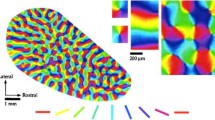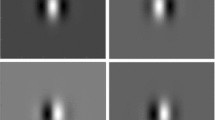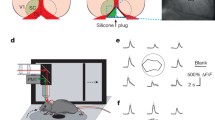Abstract
The input to primary visual cortex is embedded in a high dimensional feature space whose dimensions include position in visual space, preferred orientation, ocular dominance etc. Since all cells in a column with axis perpendicular to the cortical surface have approximately the same properties [4], this space is effectively mapped on a two-dimensional space, the cortical plane. This dimension reduction leads to complex maps which so far have evaded intuitive understanding. We show that their most salient features can be understood from a few basic design principles, in particular, local correlation, isotropy and homogeneity. These principles can be defined most easily in the Fourier domain where they correspond to a power spectrum which has a rather simple annulus-like structure. After inverse Fourier transformation, we obtain maps of orientation column structures which are very similar to the experimentally observed orientation column maps of the cat. We show this by comparison with maps which were obtained by optical imaging methods. We expect that many of the models which have been developed to explain the mapping of the preferred orientations (e.g., [5, 7, 6, 8, 10, 11, 13]) can be subsumed under our approach.
Access this chapter
Tax calculation will be finalised at checkout
Purchases are for personal use only
Preview
Unable to display preview. Download preview PDF.
Similar content being viewed by others
Reference
G.G. Blasdel. Personal communication.
G.G. Blasdel and G. Salama. Voltage-sensitive dyes reveal a modular organization in monkey striate cortex. Nature, 321:579–585, 1986.
T. Bonhoeffer and A. Grinvald. Iso-orientation domains in cat visual cortex are arranged in pinwheel-like patterns. Nature, 353:429–431, 1991.
D.H. Hubel and T.N. Wiesel. Receptive fields and functional architecture of monkey striate cortex. J. Physiol., 195:215–243, 1968.
R. Linsker. From basic network principles to neural architecture: Emergence of orientation columns. Proc. Natl. Acad. Sci. USA, 83:8779–8783, 1986.
K.D. Miller. Development of orientation columns via competition between ON-and OFF-center inputs. Neuroreport, 3:73–76, 1992.
M.M. Nass and L.N. Cooper. A theory for the development of feature detecting cells in visual cortex. Biological Cybernetics, 19:1–18, 1975.
K. Obermayer, H. Ritter, and K. Schulten. A principle for the formation of the spatial structure of cortical feature maps. Proc. Natl. Acad. Sci. USA, 87:8345–8349, 1990.
A.S. Rojer and E.L. Schwartz. Cat and monkey cortical columnar patterns modeled by bandpass-filtered 2d white noise. Biol. Cybern., 62:381–391, 1990.
N.V. Swindale. A model for the formation of orientation columns. Proc. R. Soc. Lond. B., 215:211–230, 1982.
N.V. Swindale. Iso-orientation domains and their relationship with cytochrome oxidase patches. In Models of the Visual Cortex, pages 452–461. Rose, D.; Dobson, V.G., John Wiley and Sons Ltd., 1985.
D.Y. Ts’o, R.D. Frostig, E. Lieke, and A. Grinvald. Functional organization of primate visual cortex revealed by high resolution optical imaging of intrinsic signals. Science, 249:417–423, 1990.
C. von der Malsburg and J.D. Cowan. Outline of a theory for the ontogenesis of iso-orientation domains in visual cortex. Biological Cybernetics, 45:49–56, 1982.
Author information
Authors and Affiliations
Editor information
Editors and Affiliations
Rights and permissions
Copyright information
© 1993 Springer Science+Business Media New York
About this chapter
Cite this chapter
Niebur, E., Wörgötter, F. (1993). Orientation Columns from First Principles. In: Eeckman, F.H., Bower, J.M. (eds) Computation and Neural Systems. Springer, Boston, MA. https://doi.org/10.1007/978-1-4615-3254-5_62
Download citation
DOI: https://doi.org/10.1007/978-1-4615-3254-5_62
Publisher Name: Springer, Boston, MA
Print ISBN: 978-1-4613-6431-3
Online ISBN: 978-1-4615-3254-5
eBook Packages: Springer Book Archive




